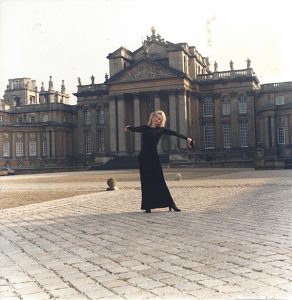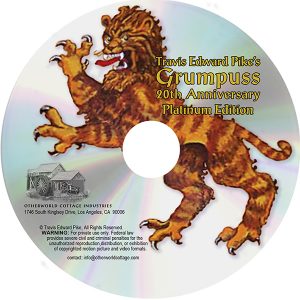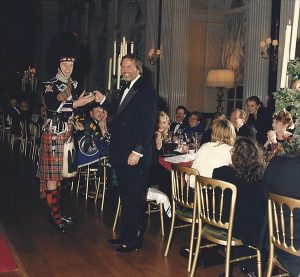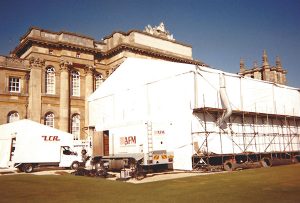ABOUT THE CURRENT RELEASE OF HIS 20TH ANNIVERSARY PLATINUM EDITION OF GRUMPUSS ON DVD.
HK: You recorded your live performance of Grumpuss on PAL Digibeta. Was that a benefit or impediment to preparing the 20th Anniversary Platinum Edition DVD?
Anniversary Platinum Edition DVD?
TP: Given my restricted budget, a film shoot, with equipment rentals, raw stock, and processing was prohibitively expensive, and did not allow the instant feedback available in the digital media, especially important when you must capture the entire show in a single afternoon, before a live audience, with no possibility of reshooting any elements not captured that day. Furthermore, the show was created for a television and home video release, and digital equipment requires less physical space and is less cumbersome where space is limited, as ours was. By then, many major motion pictures were being edited on AVID workstations, so had it been shot and processed on film, it would still have had to be digitized for editing. So, for this Grumpuss 20th Anniversary Platinum Edition, it was enormously beneficial to have had it recorded and mastered on Digibeta, especially when it came to having it reformatted by Deluxe Entertainment Services. They were able to convert it to NTSC at the same time they formatted it for DVD. The conversion from PAL to NTSC was necessary because NTSC DVD’s play on PAL, but not the other way around. The finished file looked great, but then it had to be authored for the DVD release.
HK: Authoring? I thought you transferred your master. Did you also re-edit the show?
TP: No. Authoring is industry jargon for subdividing a master into digitally manageable segments, or “chapters,” as they appear in a DVD menu. The show is still the original World Premiere performance, but the audio and visual presentation are both enormously enhanced over the old VHS tape version. I did create some additional material, the “bonus features” audiences expect on DVD purchases. We set up a couple of cameras and I provided some “live” background information about the evolution of Grumpuss and its production process, and put together three slideshows to illustrate some of the key elements in that process.
HK: I was rather amazed by how many hats you wore technically and as writer, producer, director, composer, and star of the show.
TP: That was not the original plan, but mostly a matter of budget and time constraints. Starting with the writing, of course, the epic rhyme was written long before the live show was a consideration, but when it was determined that the world premiere performance was to be a benefit for the Save the Children Fund, I realized that I should work the “Save the Children” theme into the production, and for that, I came up with the Queen of the Sidh and the waifs held in thrall immediately before being taken into her sidh, a region of the Otherworld from which mortals rarely return. Half-way between this world and the next, the girls had already lost the power of speech when the bard arrives, and the first indication that they were no longer in the Fairy Queen’s thrall, came when they spoke! A subtlety probably not immediately understood by the audience, but consistent with the folkloric sources.
 Writing in the Save the Children material was easy, and the Fairy Queen, Anna Scott, and all the rhythmic gymnasts learned their parts far in advance. But in memorizing the rhyme, I forgot that I had lines with Anna and the kids until Anna asked me, the day before the actual event, if I’d run through her lines with her. I didn’t even have a copy with me, so I had to read along with her. I could see she began to fear the worst, but I told her not to worry. I’d pick up my cues from her lines and we’d ad lib, if necessary. I have to admit, she looked a bit doubtful, but she’s a genuinely talented Thespian and while my lines were somewhat fluid, I knew where they were going, so we managed to muddle through rather brilliantly. The bigger distraction was that, having never once had an opportunity for a walk through, she and the waifs weren’t always ready to get back on stage on time. But it was a charity affair and the audience was on our side from the very start, so we found ways to make it all work.
Writing in the Save the Children material was easy, and the Fairy Queen, Anna Scott, and all the rhythmic gymnasts learned their parts far in advance. But in memorizing the rhyme, I forgot that I had lines with Anna and the kids until Anna asked me, the day before the actual event, if I’d run through her lines with her. I didn’t even have a copy with me, so I had to read along with her. I could see she began to fear the worst, but I told her not to worry. I’d pick up my cues from her lines and we’d ad lib, if necessary. I have to admit, she looked a bit doubtful, but she’s a genuinely talented Thespian and while my lines were somewhat fluid, I knew where they were going, so we managed to muddle through rather brilliantly. The bigger distraction was that, having never once had an opportunity for a walk through, she and the waifs weren’t always ready to get back on stage on time. But it was a charity affair and the audience was on our side from the very start, so we found ways to make it all work.
All five of us had as much trouble – or more — with my music cues. I’d created them month’s earlier, marked up a copy of the rhyme, and left them for David Carr to arrange. And, another reason NOT to wear so many hats, is that I failed to make a copy of that poem indicating where the music cues came. Although by show time, I was confident in my ability to perform the rhyme, there were some oversights that, in a different situation, in front of a different crowd, might have spelled disaster.
HK: So the outtakes and false starts from the live show, now included as bloopers in the end credits, were the result of oversights on your part? Do you think they take away or dilute the fresh “first take” run through that we see on screen?
TP: Some, I would attribute to my oversights, but many were the result of problems like noisy fireworks in Oxford (some distance from my venue, heard in the soundtracks), and some cabling issues, but they aren’t bloopers, they’re technical difficulties — not funny, just annoying, so I didn’t include any of them. Others were the result of the incredible time constraints on the production, but everyone, including my excellent audience, carried on regardless, dealing with each problem as it arose, so I included the bloopers in the end credits to acknowledge and celebrate the success of the one-night stand, a live performance, without a single camera rehearsal.
HK: One of the new bonus features really shows your dedication and determination to mount this as a stage presentation. Somehow that landed you in England, at probably, the right venue for your vision, but there were some false starts finding a home.
TP: After I composed the rhyme, I wrote a screenplay for a live action feature motion picture, but the cost of such a production was out-of-reach for  Otherworld Entertainment, so I had to submit it to the major studios. My daughter said the studio readers would reject a story to be performed entirely in rhyme, unless they could “hear” how it worked, to which end, she recommended I record it in character, in a recording studio, and submit a tape of my performance along with the screenplay. I did, but although the recording was excellent, all but one of major studios passed on the project, and the one that expressed interest, wanted the story without the rhyme. By then I had been growing this epic adventure, entirely in rhyme, for some thirty years, and I refused to scrap the rhyme. I began considering publishing Grumpuss in an illustrated, leather-bound book, with the look of a medieval manuscript, but quickly learned that it would be a very expensive proposition to produce it, and the cost to would-be collectors would run in excess of $100.00 per copy. But there was a singular, and ultimately pivotal result of my recorded audio performance. I could play the recording of Grumpuss for friends, family and potential investors, which freed me to listen with them and judge their reactions.
Otherworld Entertainment, so I had to submit it to the major studios. My daughter said the studio readers would reject a story to be performed entirely in rhyme, unless they could “hear” how it worked, to which end, she recommended I record it in character, in a recording studio, and submit a tape of my performance along with the screenplay. I did, but although the recording was excellent, all but one of major studios passed on the project, and the one that expressed interest, wanted the story without the rhyme. By then I had been growing this epic adventure, entirely in rhyme, for some thirty years, and I refused to scrap the rhyme. I began considering publishing Grumpuss in an illustrated, leather-bound book, with the look of a medieval manuscript, but quickly learned that it would be a very expensive proposition to produce it, and the cost to would-be collectors would run in excess of $100.00 per copy. But there was a singular, and ultimately pivotal result of my recorded audio performance. I could play the recording of Grumpuss for friends, family and potential investors, which freed me to listen with them and judge their reactions.
One such visitor was Dr. Judith Stanton, an English professor at Massachusetts’ Bridgewater State College. She loved it and asked if she could have a copy to play for her classes studying Homer and Virgil. I made her a cassette copy and a little over two years later received a letter from her, saying how she had used Grumpuss to stimulate discussion of the way fragments of culture may be reintegrated, (which helped them develop an appreciation of both the oral and written traditions), then went on to request its use with Senior English majors in her Myth and Modern Poetry Seminar that fall (demonstrating that the tradition remains fertile and that new mythic characters of substance are still being created), and closed with her hope that I could arrange for the general public to meet him soon.
I shared that letter with some of my closest friends, and one of them said that if I wanted to go forward with Grumpuss, he’d kick in $50,000. Well, that certainly gave me something to consider. Ultimately, I decided that I could protect the rhyme, and reintroduce bardic epic poetry to the modern world by getting a well-known actor to perform it, live, in a medieval setting (preferably where such events had actually occurred in the distant past), before an audience in Medieval costuming, and might be able to place it with PBS. If that worked, I might then consider making a deal to do the feature film without the rhyme.
I began scouting UK locations for it at the same time I was scouting for the musical fantasy I now call Changeling’s Return. With a working budget of three million dollars for a Grumpuss TV Special, I found a perfect venue in Penshurst Place, Tunbridge, Kent and sent the professor’s letter around to all of my friends. Three million proved to be too much for my investors, and hiring a star to play the Bard seemed to them to be a waste of money, especially since what had inspired them (and the professor), was my performance. Faced with their support (and demands), I recomputed my budget, and decided if I played the Bard, I might be able to bring it in for closer to $300,000.
If we’re counting hats, I was now the writer, producer, director and star of the show. Well, I could certainly compose the music I needed (hat number five), and my friend David Carr could arrange and conduct the orchestra for me, but how would I attract an audience in the UK, where I was virtually, if not completely unknown. A friend in England offered a solution. If I arranged to do it as a charity gala, the audience would come for the charity. He even had one in mind. Since Grumpuss was family-friendly, I should approach the Save the Children Fund, one of the most popular charities in the UK.
 HK: But you never made Grumpuss for $300,000.
HK: But you never made Grumpuss for $300,000.
TP: No. With the involvement of the Save the Children Fund, it was determined that it would have to be staged in a celebrity venue, and my first choice, Penshurst Place, albeit home of Sir Philip Sydney, author of the treatise in Defence of Poesy, statesman, scholar, and favorite of Elizabeth I of England, whose medieval hall had been built more than a hundred years before Columbus got his boats, had been turned into a restaurant.
I began a frantic search for another suitable venue, and while many of the sites I visited had excellent histories and links that I might exploit, none of them were quite large enough for my production. At a production meeting with my British staff, the discussion of a venue became of paramount importance, and one wag suggested for my world premiere of Grumpuss, nothing less than Blenheim Palace would do. In my ignorance, I asked why that hadn’t been on my list, and requested that it be added and a visit to be arranged forthwith. In fact, the rascal was right. Blenheim Palace suited me to a T, but another stipulation was that there should be a dinner, afterwards, and that “souvenir gifts” were expected at such charity galas. “Bucks up” as we sometimes say in the motion picture industry.
My budget instantly rose more than $500,000, but a celebrity venue, with celebrities present to encourage ticket sales, should cover the difference, and to be on the safe side, I set up, with one of the investors, a $400,000 line of credit originally intended for distribution and advertising. The rest, as they say, is history.
HK: Your wife, Judy, told me that on her tour of Blenheim Palace, the docent apologized to the tourist group for the erection of the massive tent that was your theater outside the South façade, explaining that while it might be unsightly, it was paying for the palace’s new roof.
TP: Judy told me that, too.
HK: What are your feelings and observations about working in a digital video format and then, years later, making it available on DVD? Do you like the DVD configuration?
TP: Since this live performance of Grumpuss was always intended to go to television and home video, it was a most happy choice – compact and providing excellent sound and picture quality, now particularly evident in its new DVD configuration. As for my feelings about DVDs overall, you’ve seen my DVD library of more than 3,000 movies, television productions, and college classes. When you consider the space required to store reels of 35mm feature films, in the space I have allotted to my library, my father could not have stored more than 30-50 titles. And then add to that all the room required for a projection booth, two 35mm projectors, rewinds, platters, widescreen, voice of the theater sound, et al.
HK: I should add that you started, a half century ago, with film stock productions and movies. How do you feel about the digital domain and how has digital impacted or informed your work the last few decades?
TP: I’m all in. I was a pioneer of digital ADR (automated dialog replacement), having done digital post-production, primarily dubbing foreign  language films into English for nearly 30 years when I finally did Grumpuss. As for this production, there would be no splicing, no lost generations, no enormous trucks and huge shipping costs – and minimal raw stock costs. I admit I sometimes miss the smell of the film, the feel of it running through my hand on the rewinds, and the whir of it going through the sprockets on the Moviola or flatbed editing table. I suppose that’s the worst kind of nostalgia, a rare, but suddenly overwhelming sense of a lost past, but I suspect kids reared on farms probably feel the same way about the smell of livestock or new-mown hay. But those smells are still there. You can revisit them and experience a rush of happy memories. Why do you suppose so many people are still tuned into vinyl, even acetate recordings? Sound is part of it, of course, but so is the smell.
language films into English for nearly 30 years when I finally did Grumpuss. As for this production, there would be no splicing, no lost generations, no enormous trucks and huge shipping costs – and minimal raw stock costs. I admit I sometimes miss the smell of the film, the feel of it running through my hand on the rewinds, and the whir of it going through the sprockets on the Moviola or flatbed editing table. I suppose that’s the worst kind of nostalgia, a rare, but suddenly overwhelming sense of a lost past, but I suspect kids reared on farms probably feel the same way about the smell of livestock or new-mown hay. But those smells are still there. You can revisit them and experience a rush of happy memories. Why do you suppose so many people are still tuned into vinyl, even acetate recordings? Sound is part of it, of course, but so is the smell.
HK: Personally, revisiting your history, once again illustrates the unique and inspiring journey you embarked on . . . or were placed upon to navigate. Be it medical interruptions during your military stint, or playing music before the 1964 British Invasion, or releasing music and audio and video products before the internet, you’ve just done your trip, which began in the retail universe over a half century ago. And, in the process, it underscores that you just have to keep going, against all odds, with or without support from the entertainment world. The multiple endeavors that are constantly in process stemming from your initial vision are coming to fruition, and you have also remained in a position of ownership which is an added bonus of longevity and sticking with the game. I’m delighted to see several of your reissues and re-releases and anniversary editions of your action, and new 2016 and 2017 works, connecting to listeners, viewers, and readers, even after age 70!
TP: Thank you.
More information can be found here:
http://www.travisedwardpike.com






